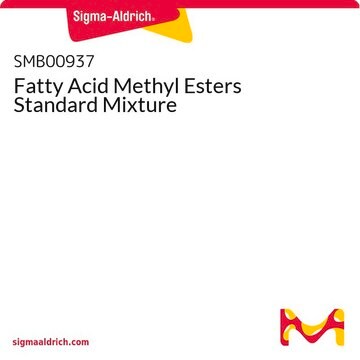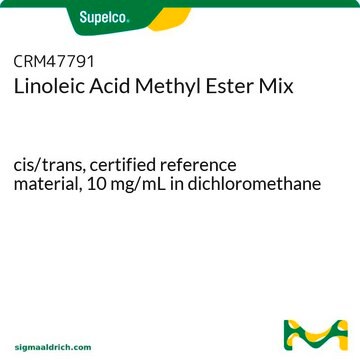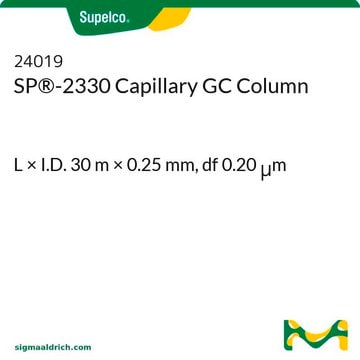24317
Columna para GC capilar SP®-2380
L × I.D. 100 m × 0.25 mm, df 0.20 μm
Iniciar sesiónpara Ver la Fijación de precios por contrato y de la organización
About This Item
UNSPSC Code:
41115710
eCl@ss:
32119290
Productos recomendados
material
fused silica
agency
meets requirements for USP G48
parameter
≤25-275 °C temperature (isothermal or programmed)
Beta value
313
df
0.20 μm
technique(s)
gas chromatography (GC): suitable
L × I.D.
100 m × 0.25 mm
matrix active group
Stabilized; poly(90% biscyanopropyl/10% cyanopropylphenyl siloxane) phase
application(s)
agriculture
chemicals and industrial polymers
clinical
food and beverages
column type
capillary highly polar
¿Está buscando productos similares? Visita Guía de comparación de productos
General description
Capillary GC column is also known as open tubular column. The carrier gas flows through the central aperture and is unrestricted throughout the length of the column.
Aplicación: Una columna muy polar de cianosiloxano utilizada habitualmente para la separación de los isómeros geométricos (cis/trans) de los ésteres metílicos de los ácidos grasos (FAME) como grupo. También útil cuando se requiere una columna muy polar de uso general con buena estabilidad térmica.
Código USP: Esta columna cumple los requisitos de USP G48.
Fase:
Código USP: Esta columna cumple los requisitos de USP G48.
Fase:
- Estabilizada
- Poli(biscianopropil 90 %/cianopropilfenil siloxano 10 %)
- Subambiente a 275 °C (isotérmica o programada)
Application
- SP®-2380 Capillary Column may be used for determination of fatty acid composition in crude oil in capillary gas chromatography, used along with normal and reverse-phase high-performance liquid chromatography (HPLC) in order to study the content and composition of tocopherols, sterols, and phospholipids in soybean oils derived from genetically-modified soybeans.
- It was used for the identification of fatty acid methyl esters from mammalian samples by fast gas chromatography.
- It was used for determining the hydrogenation level and the level of isomerisation development during the hydrogenation process of edible oils by capillary gas chromatography.
- It was also used in gas chromatography equipped with flame ionization detector (FID) for analysing the cytotoxicity of fatty acids from seed oils containing conjugated linolenic acids (CLN) on mouse tumor and human monocytic leukemia cells.
Other Notes
We offer a variety of chromatography accessories including analytical syringes
Legal Information
SP is a registered trademark of Sigma-Aldrich Co. LLC
Choose from one of the most recent versions:
¿Ya tiene este producto?
Encuentre la documentación para los productos que ha comprado recientemente en la Biblioteca de documentos.
Los clientes también vieron
E M Bondia et al.
Journal of chromatography. B, Biomedical applications, 658(2), 369-374 (1994-08-19)
Total fatty acids in plasma of neonates have been analysed as their methyl esters by gas chromatography. They were separated on a capillary column coated with a SP-2380 stationary phase. As little as 100 microliters of plasma is used for
Effect of genetic modification on the content and composition of bioactive constituents in soybean oil.
Mounts TL
Journal of the American Oil Chemists' Society, 73 (5), 581-586 (1996)
R Suzuki et al.
Lipids, 36(5), 477-482 (2001-07-04)
The cytotoxicity of fatty acids from seed oils containing conjugated linolenic acids (CLN) was studied. Fatty acids from pomegranate, tung, and catalpa were cytotoxic to human monocytic leukemia cells at concentrations exceeding 5 microM for pomegranate and tung and 10
Fast gas chromatography for the identification of fatty acid methyl esters from mammalian samples.
Stark K and Salem N.
Liposome Technology, 17 (8), 181-181 (2005)
Use of capillary gas chromatography for determining the hydrogenation level of edible oils.
Mateja N and Smidovnik A.
Journal of Chromatography A, 767 (1), 335-339 (1997)
Nuestro equipo de científicos tiene experiencia en todas las áreas de investigación: Ciencias de la vida, Ciencia de los materiales, Síntesis química, Cromatografía, Analítica y muchas otras.
Póngase en contacto con el Servicio técnico







